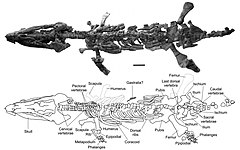| Thalassophoneans | |
|---|---|

| |
| Liopleurodon ferox | |

| |
| Sachicasaurus vitae | |
| Scientific classification | |
| Domain: | Eukaryota |
| Kingdom: | Animalia |
| Phylum: | Chordata |
| Class: | Reptilia |
| Superorder: | †Sauropterygia |
| Order: | †Plesiosauria |
| Family: | †Pliosauridae |
| Clade: | †Thalassophonea Benson & Druckenmiller, 2013 |
| Subgroups | |
Thalassophonea is an extinct clade of pliosaurids from the Middle Jurassic to the early Late Cretaceous (Callovian to Turonian) of Australia, Europe, North America and South America. Thalassophonea was erected by Roger Benson and Patrick Druckenmiller in 2013. The name is derived from Greek thalassa (θάλασσα), "sea", and phoneus (φονεύς), "murderer". It is a stem-based taxon defined as "all taxa more closely related to Pliosaurus brachydeirus than to Marmornectes candrewi".[1] It includes the short necked and large headed taxa that typify the family.[2][3] The largest representatives reached 10–11 metres (33–36 ft), in length, with around a quarter of this length being the head. Thalassophonean pliosaurs represented the largest marine predators during their existence, spanning more than 80 million years.[2]
- ^ Benson, R. B. J.; Druckenmiller, P. S. (2014) [first published online 2013]. "Faunal turnover of marine tetrapods during the Jurassic-Cretaceous transition". Biological Reviews. 89 (1): 1–23. doi:10.1111/brv.12038. PMID 23581455. S2CID 19710180.
- ^ a b N. G. Zverkov, E. M. Pervushov (2020). "A gigantic pliosaurid from the Cenomanian (Upper Cretaceous) of the Volga Region, Russia". Cretaceous Research. 110. doi:10.1016/j.cretres.2020.104419.
- ^ Sachs, S.; Madzia, D.; Thuy, B.; Kear, B.P. (October 16, 2023). "The rise of macropredatory pliosaurids near the Early-Middle Jurassic transition". Scientific Reports. 13 (17558): 1–16. doi:10.1038/s41598-023-43015-y. PMC 10579310.